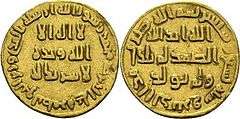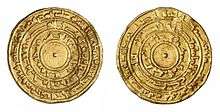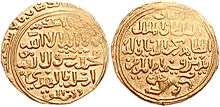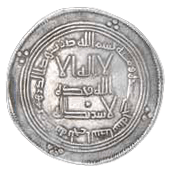Gold dinar
The gold dinar (Arabic: ﺩﻳﻨﺎﺭ ذهبي) is an Islamic medieval gold coin first issued in AH 77 (696–697 CE) by Caliph Abd al-Malik ibn Marwan. The weight of the dinar is 1 mithqal (4.25 grams).



The word dinar comes from the Latin word denarius, which was a silver coin. The name "dinar" is also used for Sasanid, Kushan, and Kidarite gold coins, though it is not known what the contemporary name was.
The first dinars were issued by the Umayyad Caliphate. Under the dynasties that followed the use of the dinar spread from Islamic Spain to Central Asia.
Background
Although there was a dictum that the Byzantine solidus was not to be used outside of the Byzantine empire, there was some trade that involved these coins which then did not get re-minted by the emperors minting operations, and quickly became worn. Towards the end of the 7th century CE, Arabic copies of solidi – dinars issued by the caliph Abd al-Malik (685–705 CE), who had access to supplies of gold from the upper Nile – began to circulate in areas outside of the Byzantine empire. These corresponded in weight to only 20 carats (4.0 g), but matched with the weight of the worn solidi that were circulating in those areas at the time. The two coins circulated together in these areas for a time.[1]
First dated coins
The first dated coins that can be assigned to the Muslims are copies of silver Dirhams of the Sassanian ruler Yazdegerd III, struck during the Caliphate of Uthman. These coins differ from the original ones in that an Arabic inscription is found in the obverse margins, normally reading "in the Name of Allah". The subsequent series was issued using types based on drachmas of Khosrau II, whose coins probably represented a significant proportion of the currency in circulation.
In parallel with the later Khosrau-type Arab-Sassanian coins, first issued under the Well-Guided Caliphs of Islam, a more extensive series was struck with Khosrau's name replaced by that of the local Arab governor or, in two cases, that of the Caliph. Historical evidence makes it clear that most of these coins bear Hijra dates. The earliest Muslim copper coins are anonymous and undated but a series exists which may have been issued during the Caliphates of Uthman or Ali. These are crude copies of Byzantine 12-nummus pieces of Heraclius from Alexandria.
First silver dirham

By the year AH 75 (695 CE) Abd al-Malik had decided on changes to the coinage. A scattering of patterned pieces in silver exist from this date, based on Sassanian prototypes but with distinctive Arabic reverses. This experiment, which maintained the Sassanian weight standard of 3.5–4.0 grams was not proceeded with, and in 698 CE (AH 79) a completely new type of silver coin was struck at 14 mints to a new nominal weight of 2.97 grams. Unlike the contemporary gold coinage, this figure does not seem to have been achieved in practice. The average weight of sixty undamaged specimens of 698-704 (AH 79–84) is only 2.71 grams, a figure very close to that for a unique coin of 698 (AH 79) struck with no mint name (as was the standard procedure for the gold dinars produced in Damascus). These new coins which bore the name of 'dirham', established the style of the Arab-Sassanian predecessors at 25 to 28 mm in diameter. Their design is composed of Arabic inscriptions surrounded by circles and annulets.
On each side there is a three- or four-line legend with a single circular inscription. Outside this are three line circles with, at first, five annulets surrounding them. The side normally taken as the obverse has as its central legend the Kalima or shahada: "There is no god except Allah alone, there is no partner with Him." Around it is the mint and date formula reading "In the Name of Allah: this Dirham was struck in [mint name e.g. Damascus] the year [e.g. 698, AH 79]". The reverse has a four line central inscription taken from the Surah 112 of the Quran; "Qul hu Allahu Ahad, Allahu-Samad, Lam yalid wa lam yulad wa lam yakul-lahu kufu-an ahad"'. The marginal legend states: "Muhammad is the Messenger of Allah, he was sent with guidance and the religion of truth to make it prevail over every other religion, averse though the idolaters may be" (Quran 9:33)
First gold dinar
The gold coins were first struck to the contemporary standard of 4.4 grams and with one or more Arabic Standing figures on the obverse and an Arabic legend on the reverse. Dated coins exist from 680 (AH 74) and are named as 'Dinars'. These experimental issues were replaced in 683 (AH 77), except in North Africa and Spain, by completely epigraphical designs very similar to the designs adopted for the silver pieces but with a shorter reverse legend and no annulets or inner circles. This type was used without appreciable change for the whole of Umayyad period, the coins being struck to a new and carefully controlled standard of 4.25 grams. This weight was reputed to be based on the average of the current Byzantine solidi, was called a Mithqal, a term used earlier for 1⁄72 of a ratl. Evidence of the importance attached to the close control of the new Dinars is provided by the existence of glass weights, mainly from Egypt. They usually show the governor's name, sometimes the date but all marked with coin denomination.[2]
The issues in gold from North Africa began as copies of the coins of Heraclius and his son (but with an abbreviated Kalima in Latin), the reverse "cross on steps" losing in most cases its cross piece. Dinars, halves and thirds were struck, all to the new weight standard. Later coins are dated by indiction, from Indiction II (703, AH 84–85) changing to the Hijra date in Roman numerals in 713 (AH 94) with Arabic phrases appearing in the field from 716 (AH 97). In 684 (AH 100), North Africa came into line with the eastern issues although the mint is named as Ifriqiya. The legends are shorter and the reverse has a new central inscription: "In the Name of Allah, the Merciful, the Compassionate". This was used also on the coins from Al-Andalus, and on the half and third Dinars, most of which show no mint but may well have been struck in Al-Andalus.
Modern use
See also
References
- Porteous 1969
- Broome, Michael. "A Handbook of Islamic Coins." (Page 11)
Porteous, John (1969). "The Imperial Foundations". Coins in History: A Survey of Coinage from the Reform of Diocletian to the Latin Monetary Union. Weidenfeld and Nicolson. pp. 14–33. ISBN 0-297-17854-7.
External links
| Wikimedia Commons has media related to Golden dinar. |
